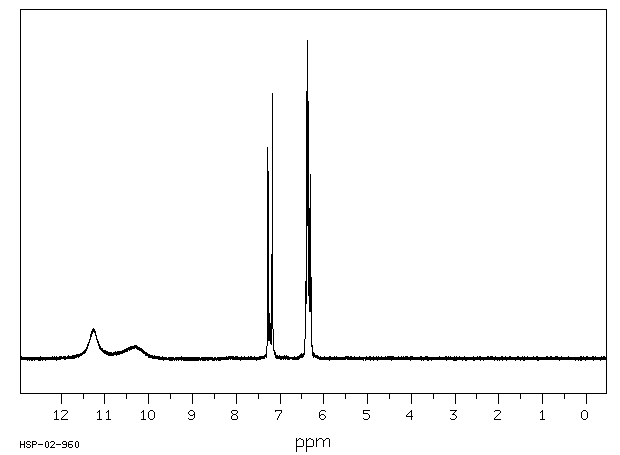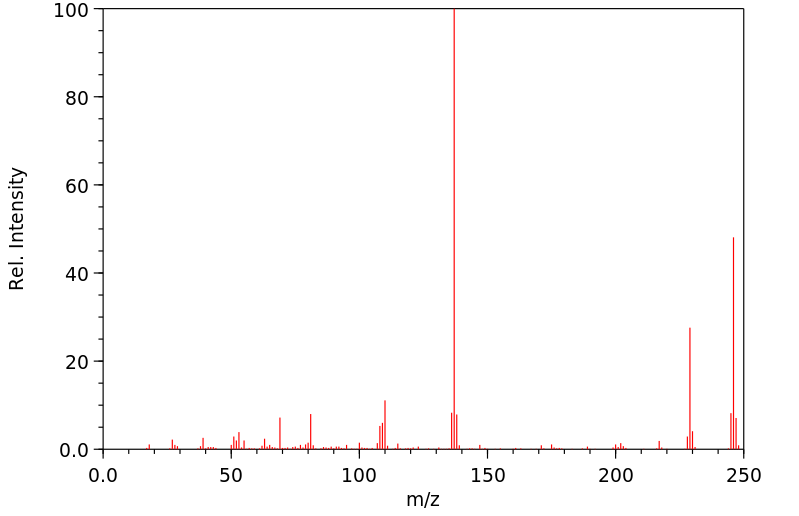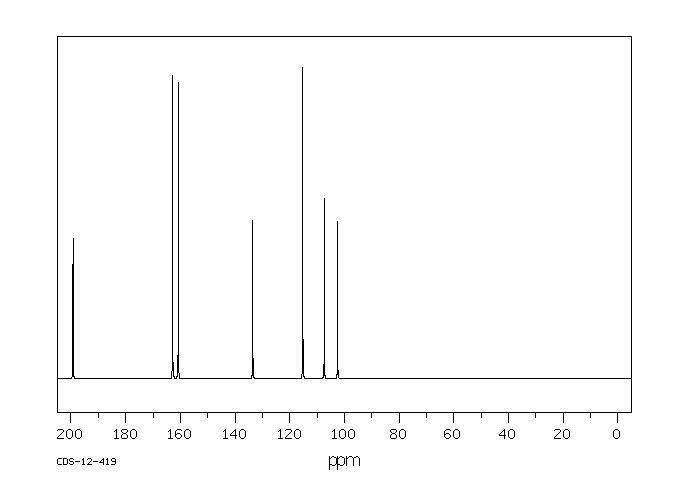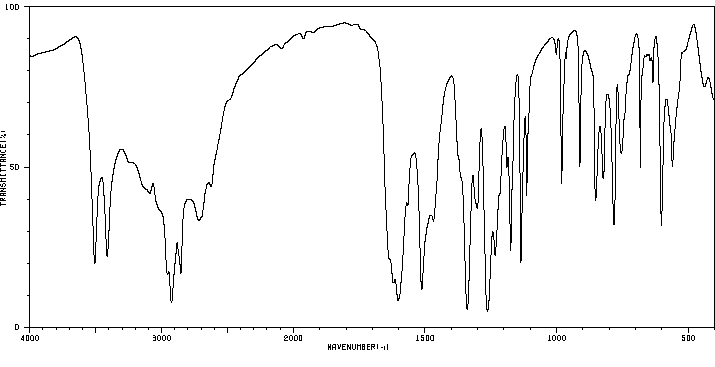2,2',4,4'-四羟基二苯甲酮 | 131-55-5
-
物化性质
-
计算性质
-
ADMET
-
安全信息
-
SDS
-
制备方法与用途
-
上下游信息
-
文献信息
-
表征谱图
-
同类化合物
-
相关功能分类
-
相关结构分类
物化性质
-
熔点:198-200 °C(lit.)
-
沸点:349.21°C (rough estimate)
-
密度:1.216
-
溶解度:DMSO(轻微,超声处理),甲醇(轻微)
-
LogP:3.091 (est)
-
物理描述:DryPowder
-
颜色/状态:Yellow needles
-
蒸汽压力:1.6X10-11 mm Hg at 25 °C (est)
-
稳定性/保质期:
Stable under recommended storage conditions.
-
分解:When heated to decomposition it emits toxic fumes of /nitrogen oxides/.
-
解离常数:pKa1 = 7.1; pka2 = 7.9 (est)
-
碰撞截面:151.99 Ų [M-H]-; 152 Ų [M+H]+
计算性质
-
辛醇/水分配系数(LogP):2.4
-
重原子数:18
-
可旋转键数:2
-
环数:2.0
-
sp3杂化的碳原子比例:0.0
-
拓扑面积:98
-
氢给体数:4
-
氢受体数:5
ADMET
安全信息
-
TSCA:Yes
-
危险品标志:Xn
-
安全说明:S26,S36,S37/39
-
危险类别码:R22,R36/37/38
-
WGK Germany:3
-
海关编码:2914501900
-
RTECS号:DJ1892000
-
包装等级:II; III
-
危险类别:4.1
-
危险性防范说明:P261,P305+P351+P338
-
危险性描述:H302,H315,H319,H335
-
储存条件:通风、低温、干燥
SDS
模块 1. 化学品
1.1 产品标识符
: 2,2′,4,4′-四羟基二苯甲酮
产品名称
1.2 鉴别的其他方法
无数据资料
1.3 有关的确定了的物质或混合物的用途和建议不适合的用途
仅用于研发。不作为药品、家庭或其它用途。
模块 2. 危险性概述
2.1 GHS-分类
急性毒性, 经口 (类别 4)
皮肤刺激 (类别 2)
眼睛刺激 (类别 2A)
特异性靶器官系统毒性(一次接触) (类别 3)
2.2 GHS 标记要素,包括预防性的陈述
象形图
警示词 警告
危险申明
H302 吞咽有害。
H315 造成皮肤刺激。
H319 造成严重眼刺激。
H335 可能引起呼吸道刺激。
警告申明
预防措施
P261 避免吸入粉尘/烟/气体/烟雾/蒸气/喷雾.
P264 操作后彻底清洁皮肤。
P270 使用本产品时不要进食、饮水或吸烟。
P271 只能在室外或通风良好之处使用。
P280 穿戴防护手套/ 眼保护罩/ 面部保护罩。
事故响应
P301 + P312 如果吞咽并觉不适: 立即呼叫解毒中心或就医。
P302 + P352 如果皮肤接触:用大量肥皂和水清洗。
P304 + P340 如吸入: 将患者移到新鲜空气处休息,并保持呼吸舒畅的姿势。
P305 + P351 + P338 如与眼睛接触,用水缓慢温和地冲洗几分钟。如戴隐形眼镜并可方便地取
出,取出隐形眼镜,然后继续冲洗.
P312 如感觉不适,呼救中毒控制中心或医生.
P321 具体处置(见本标签上提供的急救指导)。
P330 漱口。
P332 + P313 如觉皮肤刺激:求医/就诊。
P337 + P313 如仍觉眼睛刺激:求医/就诊。
P362 脱掉沾污的衣服,清洗后方可再用。
安全储存
P403 + P233 存放于通风良的地方。 保持容器密闭。
P405 存放处须加锁。
废弃处置
P501 将内容物/ 容器处理到得到批准的废物处理厂。
2.3 其它危害物 - 无
模块 3. 成分/组成信息
3.1 物 质
: C13H10O5
分子式
: 246.22 g/mol
分子量
组分 浓度或浓度范围
2,2',4,4'-Tetrahydroxybenzophenone
-
化学文摘登记号(CAS 131-55-5
No.) 205-028-9
EC-编号
模块 4. 急救措施
4.1 必要的急救措施描述
一般的建议
请教医生。 向到现场的医生出示此安全技术说明书。
吸入
如果吸入,请将患者移到新鲜空气处。 如呼吸停止,进行人工呼吸。 请教医生。
皮肤接触
用肥皂和大量的水冲洗。 请教医生。
眼睛接触
用大量水彻底冲洗至少15分钟并请教医生。
食入
切勿给失去知觉者通过口喂任何东西。 用水漱口。 请教医生。
4.2 主要症状和影响,急性和迟发效应
据我们所知,此化学,物理和毒性性质尚未经完整的研究。
4.3 及时的医疗处理和所需的特殊处理的说明和指示
无数据资料
模块 5. 消防措施
5.1 灭火介质
灭火方法及灭火剂
用水雾,抗乙醇泡沫,干粉或二氧化碳灭火。
5.2 源于此物质或混合物的特别的危害
碳氧化物
5.3 给消防员的建议
如必要的话,戴自给式呼吸器去救火。
5.4 进一步信息
无数据资料
模块 6. 泄露应急处理
6.1 作业人员防护措施、防护装备和应急处置程序
使用个人防护用品。 避免粉尘生成。 避免吸入蒸气、烟雾或气体。 保证充分的通风。
人员疏散到安全区域。 避免吸入粉尘。
6.2 环境保护措施
不要让产品进入下水道。
6.3 泄漏化学品的收容、清除方法及所使用的处置材料
收集和处置时不要产生粉尘。 扫掉和铲掉。 放入合适的封闭的容器中待处理。
6.4 参考其他部分
丢弃处理请参阅第13节。
模块 7. 操作处置与储存
7.1 安全操作的注意事项
避免接触皮肤和眼睛。 避免形成粉尘和气溶胶。
在有粉尘生成的地方,提供合适的排风设备。一般性的防火保护措施。
7.2 安全储存的条件,包括任何不兼容性
贮存在阴凉处。 使容器保持密闭,储存在干燥通风处。
7.3 特定用途
无数据资料
模块 8. 接触控制和个体防护
8.1 容许浓度
最高容许浓度
没有已知的国家规定的暴露极限。
8.2 暴露控制
适当的技术控制
根据良好的工业卫生和安全规范进行操作。 休息前和工作结束时洗手。
个体防护设备
眼/面保护
带有防护边罩的安全眼镜符合 EN166要求请使用经官方标准如NIOSH (美国) 或 EN 166(欧盟)
检测与批准的设备防护眼部。
皮肤保护
戴手套取 手套在使用前必须受检查。
请使用合适的方法脱除手套(不要接触手套外部表面),避免任何皮肤部位接触此产品.
使用后请将被污染过的手套根据相关法律法规和有效的实验室规章程序谨慎处理. 请清洗并吹干双手
所选择的保护手套必须符合EU的89/686/EEC规定和从它衍生出来的EN 376标准。
身体保护
全套防化学试剂工作服, 防护设备的类型必须根据特定工作场所中的危险物的浓度和数量来选择。
呼吸系统防护
如须暴露于有害环境中,请使用P95型(美国)或P1型(欧盟 英国
143)防微粒呼吸器。如需更高级别防护,请使用OV/AG/P99型(美国)或ABEK-P2型 (欧盟 英国 143)
防毒罐。
呼吸器使用经过测试并通过政府标准如NIOSH(US)或CEN(EU)的呼吸器和零件。
模块 9. 理化特性
9.1 基本的理化特性的信息
a) 外观与性状
形状: 固体
b) 气味
无数据资料
c) 气味阈值
无数据资料
d) pH值
无数据资料
e) 熔点/凝固点
熔点/凝固点: 198 - 200 °C - lit.
f) 沸点、初沸点和沸程
无数据资料
g) 闪点
无数据资料
h) 蒸发速率
无数据资料
i) 易燃性(固体,气体)
无数据资料
j) 高的/低的燃烧性或爆炸性限度 无数据资料
k) 蒸气压
无数据资料
l) 蒸汽密度
无数据资料
m) 密度/相对密度
无数据资料
n) 水溶性
无数据资料
o) n-辛醇/水分配系数
无数据资料
p) 自燃温度
无数据资料
q) 分解温度
无数据资料
r) 粘度
无数据资料
模块 10. 稳定性和反应活性
10.1 反应性
无数据资料
10.2 稳定性
无数据资料
10.3 危险反应
无数据资料
10.4 应避免的条件
无数据资料
10.5 不相容的物质
强氧化剂, 强碱
10.6 危险的分解产物
其它分解产物 - 无数据资料
模块 11. 毒理学资料
11.1 毒理学影响的信息
急性毒性
半数致死剂量 (LD50) 经口 - 大鼠 - 1,220 mg/kg
皮肤刺激或腐蚀
眼睛刺激或腐蚀
眼睛 - 兔子 - 中度的眼睛刺激
呼吸道或皮肤过敏
无数据资料
生殖细胞致突变性
细胞突变性-体外试验 - 小鼠 - 淋巴细胞
细胞发生分析
细胞突变性-体外试验 - 小鼠 - 淋巴细胞
姐妹染色单体互换
致癌性
IARC:
此产品中没有大于或等于 0。1%含量的组分被 IARC鉴别为可能的或肯定的人类致癌物。
生殖毒性
无数据资料
特异性靶器官系统毒性(一次接触)
吸入 - 可能引起呼吸道刺激。
特异性靶器官系统毒性(反复接触)
无数据资料
吸入危险
无数据资料
潜在的健康影响
吸入 吸入可能有害。 引起呼吸道刺激。
摄入 误吞对人体有害。
皮肤 通过皮肤吸收可能有害。 造成皮肤刺激。
眼睛 造成严重眼刺激。
接触后的征兆和症状
据我们所知,此化学,物理和毒性性质尚未经完整的研究。
附加说明
化学物质毒性作用登记: DJ1892000
模块 12. 生态学资料
12.1 生态毒性
无数据资料
12.2 持久性和降解性
无数据资料
12.3 潜在的生物累积性
无数据资料
12.4 土壤中的迁移性
无数据资料
12.5 PBT 和 vPvB的结果评价
无数据资料
12.6 其它不良影响
无数据资料
模块 13. 废弃处置
13.1 废物处理方法
产品
将剩余的和不可回收的溶液交给有许可证的公司处理。
联系专业的拥有废弃物处理执照的机构来处理此物质。
与易燃溶剂相溶或者相混合,在备有燃烧后处理和洗刷作用的化学焚化炉中燃烧
受污染的容器和包装
按未用产品处置。
模块 14. 运输信息
14.1 联合国危险货物编号
欧洲陆运危规: - 国际海运危规: - 国际空运危规: -
14.2 联合国运输名称
欧洲陆运危规: 非危险货物
国际海运危规: 非危险货物
国际空运危规: 非危险货物
14.3 运输危险类别
欧洲陆运危规: - 国际海运危规: - 国际空运危规: -
14.4 包裹组
欧洲陆运危规: - 国际海运危规: - 国际空运危规: -
14.5 环境危险
欧洲陆运危规: 否 国际海运危规 国际空运危规: 否
海洋污染物(是/否): 否
14.6 对使用者的特别提醒
无数据资料
上述信息视为正确,但不包含所有的信息,仅作为指引使用。本文件中的信息是基于我们目前所知,就正
确的安全提示来说适用于本品。该信息不代表对此产品性质的保证。
参见发票或包装条的反面。
模块 15 - 法规信息
N/A
模块16 - 其他信息
N/A
制备方法与用途
2,2',4,4'-四羟基二苯甲酮紫外线吸收剂 属于二苯甲酮类紫外线吸收剂系列产品,其吸收波长范围为320-400nm。这种化合物具有对称的苯环结构,并且两边都有羟基,热光化学性能稳定,优于BP-1(UV-O)。目前,该产品广泛应用于塑料、树脂、涂料、合成橡胶、感光材料及化妆品行业;近年来,在织物上的应用也越来越受纺织行业的重视。
制备在装配有搅拌器和氯化氢吸收系统的150 mL 三口烧瓶中,投入间苯二酚 1510 g (0.114 mol)、2, 4-二羟基苯甲酸 1514 g (0.11 mol)、无水 ZnCl₂ 2015 g (0.115 mol)、POCl₃ 3010 g (0.120 mol),以及溶剂环丁酮 15 mL。启动搅拌,将物料混合均匀,加热升温至70-75 ℃,保温反应2小时,直到吸收系统中很少有氯化氢气体放出为止。然后向反应瓶内缓慢加入水,搅拌直至完全溶解,再将其倒入800 mL 冷水中并充分搅拌。
静置30分钟后,冷却到20℃以下,抽滤、水洗得到粗产品。将粗产品用热水溶解后,加入活性炭处理,煮沸30分钟,热过滤冷却,析出大量淡黄色晶体。经过抽滤、洗涤和干燥,最终获得1617 g 黄色晶体产物,收率为67.19%,熔点为198-200 ℃。红外光谱(IR)结果表明:υmax (cm⁻¹) : 3350~3200 (b, s, υO-H), 1629 (s, υC=O), 1590 - 1450 (s, υ苯环), 850-650 (s, δ苯环 - H)。
用途该产品可用作医药中间体、感光材料和化妆品防紫外线添加剂等。
类别与特性类别: 有毒物品
毒性分级: 中毒
急性毒性: 口服-大鼠 LD₅₀: 1220 毫克/公斤
刺激数据: 眼睛-兔子 100 毫克,中度
可燃性危险特性: 可燃;燃烧产生有毒氮氧化物烟雾
储运特性: 通风、低温干燥
灭火剂: 干粉、泡沫、沙土、二氧化碳、雾状水
上下游信息
-
上游原料
中文名称 英文名称 CAS号 化学式 分子量 2,2'-二羟基-4,4'-二甲氧基二苯甲酮 bis(2-hydroxy-4-methoxyphenyl)-methanone 131-54-4 C15H14O5 274.273 2,2',4,4'-四甲氧基二苯甲酮 2,2',4,4'-tetramethoxybenzophenone 3555-85-9 C17H18O5 302.327 -
下游产品
中文名称 英文名称 CAS号 化学式 分子量 2,2'-二羟基-4,4'-二甲氧基二苯甲酮 bis(2-hydroxy-4-methoxyphenyl)-methanone 131-54-4 C15H14O5 274.273 2,2’,4’-三羟基-4-甲氧基二苯甲酮 2,2',4'-trihydroxy-4-methoxybenzophenone 7392-62-3 C14H12O5 260.246 2,2'-二羟基-4-甲氧基二苯甲酮 (2-hydroxy-4-methoxyphenyl)(2-hydroxyphenyl)-methanone 131-53-3 C14H12O4 244.247 —— 2,2'-dihydroxy-4,4'-diallyloxybenzophenone 102019-02-3 C19H18O5 326.349 2,2',4,4'-四甲氧基二苯甲酮 2,2',4,4'-tetramethoxybenzophenone 3555-85-9 C17H18O5 302.327 4-甲氧基二苯甲酮 4-Methoxybenzophenone 611-94-9 C14H12O2 212.248 —— 2,2',4,4'-tetra-tert-butyldimethylsilyloxybenzophenone 265975-39-1 C37H66O5Si4 703.27 —— 2,2',4,4'-Tetrahydroxybenzophenon-tetrakis(trifluormethansulfonat) 17763-89-2 C17H6F12O13S4 774.472
反应信息
-
作为反应物:描述:2,2',4,4'-四羟基二苯甲酮 在 吡啶 、 sodium acetate 作用下, 以 二氯甲烷 、 水 、 二甲基亚砜 为溶剂, 反应 26.17h, 生成 3,6-di(piperidin-1-yl)-9H-xanthen-9-one参考文献:名称:荧光corannulene衍生物的口味:合成、光谱特性和生物成像应用摘要:这里报道的是一种适用于细胞成像的荧光 corannulene 衍生物。它们源自用已知荧光团“标记”corannulene。标记的二角环烯显示出强荧光(在 MeOH 中φ F > 0.25)、良好的光稳定性和长发射波长(500 nm 至 600 nm)。细胞染色实验表明,其中几种具有优异的细胞膜通透性和靶向能力。此外,我们还发现了一种意想不到的、高效的能量从花环烯到悬垂荧光团的转移。这对玉米蒌烯研究的许多领域都有影响。DOI:10.1039/d1cc02307a
-
作为产物:描述:参考文献:名称:Preparation of hydroxylated benzophenones摘要:羟基苯甲酮是通过将完全或部分甲基化的羟基苯甲酮与AlCl.sub.3反应,然后用水水解制备的,反应在尿素类或羧酰胺类化合物的存在下进行。公开号:US05728888A1
文献信息
-
Fluorescent probe申请人:——公开号:US07524974B2公开(公告)日:2009-04-28A fluorescent probe which is represented by the following formula (I): (wherein, R1 and R2 represent hydrogen atom, or a substituent for trapping proton, a metal ion, or an active oxygen species, or the like; R3 represents a monovalent substituent; R4 and R5 represent hydrogen atom or a halogen atom; R6 represents hydrogen atom, an alkylcarbonyl group, or an alkylcarbonyloxymethyl group, provided that a combination of R1, R2, and R3 provides (1) substantially high electron density of the benzene ring to which said groups bind, so that the compound represented by the formula (I) is substantially no fluorescent before the trapping of proton, or the like, and (2) substantially reduced electron density of the benzene ring to which said groups bind, so that a compound after the trapping, which is derived from the compound represented by the formula (I) is substantially highly fluorescent after the trapping of proton or the like). A fluorescent probe having an excellent fluorescence property is provided.
-
[EN] ENCAPSULATES<br/>[FR] PRODUITS ENCAPSULÉS申请人:PROCTER & GAMBLE公开号:WO2013022949A1公开(公告)日:2013-02-14The present application relates to encapsulates, compositions, products comprising such encapsulates, and processes for making and using such encapsulates. Such encapsulates comprise a core comprising a perfume and a shell that encapsulates said core, such encapsulates may optionally comprise a parametric balancing agent, such shell comprising one or more azobenzene moieties.
-
[EN] FUSED PENTACYCLIC ANTI - PROLIFERATIVE COMPOUNDS<br/>[FR] COMPOSÉS PENTACYCLIQUES FUSIONNÉS ANTI-PROLIFÉRATIFS申请人:PHARMINOX LTD公开号:WO2012175991A1公开(公告)日:2012-12-27The present invention relates to novel compounds of formula (I) wherein X, Q, R1, R2, R3, R4, R5, R6, R7, R8, R21, R22 and R23 are as defined herein. The compounds of formula (I) are inhibitors of telomerase enzyme function and are accordingly useful for the treatment cellular proliferation disorders, such as cancer.
-
Single‐Molecule Imaging of Active Mitochondrial Nitroreductases Using a Photo‐Crosslinking Fluorescent Sensor作者:Zacharias Thiel、Pablo Rivera‐FuentesDOI:10.1002/anie.201904700日期:2019.8.12is activated sequentially by nitroreductases and light to give a photo‐crosslinked adduct of active enzymes. In combination with a general photoactivatable marker of mitochondria, we performed two‐color, three‐dimensional, single‐molecule localization microscopy. These experiments allowed us to image the sub‐mitochondrial organization of microdomains of nitroreductase activity.
-
Heterocyclic Compound申请人:Amasaki Ichiro公开号:US20100004439A1公开(公告)日:2010-01-07A compound represented by the following Formula (1): wherein, Het 1 represents a bivalent five- or six-membered aromatic heterocyclic residue and may further be substituted; X a to X d each independently represent a heteroatom and may further be substituted; Y a to Y f each independently represent a heteroatom or a carbon atom and may further be substituted; the ring bound to Het 1 may have a double bond at any position以下是您提供的化学公式(1)的中文翻译: 其中,Het1代表一个二价的五元或六元芳香杂环基团,且可以进一步被取代;Xa至Xd每个独立地代表一个杂原子,且可以进一步被取代;Ya至Yf每个独立地代表一个杂原子或一个碳原子,且可以进一步被取代;与Het1相连的环可以在任何位置有一个双键。
表征谱图
-
氢谱1HNMR
-
质谱MS
-
碳谱13CNMR
-
红外IR
-
拉曼Raman
-
峰位数据
-
峰位匹配
-
表征信息










